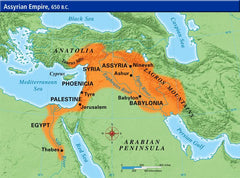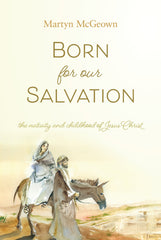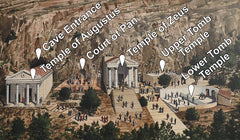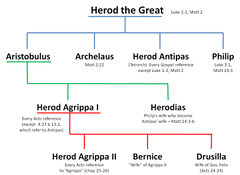Your cart is empty now.

Book Review - The Reformed Lord's Supper Form
By Rev. Martyn McGeown
A review on The Reformed Lord's Supper Form: A Commentary
________
In 2016 the Reformed Free Publishing Association presented to the English-speaking world a translation by the late Dr. Annemie Godbehere of Baastian Wielenga’s (1873-1949) Commentary on the Reformed Baptism Form. Now seven years later the same publisher presents to us a second treasure, a translation of Wielenga’s Commentary on the Reformed Lord’s Supper Form, this time by Dr. H. David Schuringa.
Baptism and the Lord’s Supper are the two sacraments which our Lord Jesus Christ gave to his church as signs and seals of his covenant of grace, as “pledges of the good will and grace of God toward us” (Belgic Confession, Art. 33). When the sacraments are celebrated in the church not only are they accompanied by the preaching, but they are also explained through the reading of forms expressly written for that purpose. Reformed believers treasure these forms as precious explanations of the sacraments, which not only expound the doctrine of the sacraments to the mind, but also apply the truth to our hearts. Wielenga writes, his words a corrective of a modern misconstrued “heart-mind” dichotomy: “True comfort indeed flows within the heart, but it reaches the heart by way of understanding! In distinction from other churches, the Reformed church of all times has professed the primacy of the intellect (the priority of understanding). When the [Heidelberg] catechism discusses the only comfort in life and death, the path then to this comfort is sought through knowledge” (104)1. Clearly, the breaking, distribution, and eating of bread, followed by the pouring, distribution, and drinking of wine in the Lord’s Supper requires explanation for the edification of God’s people.
Every member of the Protestant Reformed Churches, as well as of many other Reformed churches which use this form, is familiar with the Reformed Lord’s Supper Form. Little children and young people, even before they make confession of their faith, have heard this form read, in part or in its entirety, dozens of times; from five years old to eighteen years old, that would be just over 50 times, if we do not count the frequent reading of the preparatory section of the form. Older saints have heard it read hundreds of times, we hope with dignity, solemnity, and yet joy. Wielenga gives advice to preachers for the proper reading of the form:
The form is a fitting and heartfelt styled liturgical component, containing moving passages, and therein it is perfectly calibrated to touch the heart of the congregation, but a first requirement is that it is read out loud with the correct intonation. Avoided must be the resounding roaring, as the rapid rattling off of the form. As a liturgical presentation it must be neither recited nor lectured. The minister must merely attempt in the simple reading of the document to speak from his heart. He must bring warmth, loftiness with the tone, and this is not as easy as may appear… Further must be kept in mind that the formulary presents special requirements due to its fairly great length. If the form is not read at too great a tempo, reading it out loud requires not much less than a half-hour. Where most of the congregation has taken in the language of the form from childhood on, the liturgist must not take for granted the task to captivate the gathering for such a long time with such a well-known piece. This task requires his entire personality, the best of his ability (358-359).
Wielenga’s Commentary on the Reformed Baptism Form comprises six chapters, while the Commentary on the Reformed Lord’s Supper Form consists of nine chapters including the introduction: The Introduction; Examination of the Faith; The Commencement of Communion; The Authentic Examination; in Remembrance of Him; Altogether One Body; Lift up Our Hearts on High; The Distribution of the Bread; and the Conclusion of the Service, the commentary itself starting with chapter 3.
Chapter 3 is an exposition of the opening words of the Form, “Beloved in the Lord Jesus Christ” to “not discerning the Lord’s body.” These words, especially “Attend to,” are designed to attract the attention of the worshiping, and yet often—alas—sluggish, church: “Listen, beloved! Incline your soul’s ear, not to a man, but to your God. Attention! Your covenantal God speaks! (71). From the very beginning, the Form calls us to active faith. Wielenga expounds Jesus’ words, “Take, eat,” thus:
Therefore, following this giving is the receiving… This is an act of faith. And indeed, an act of appropriating faith. The one receiving indicates that he believes the presentation. To receive it is to say Amen to God’s bestowal of friendship. It is giving symbolic expression to faith in a (paradigmatic) claim on the gift. He who receives glorifies the divine attributes of love, truth, and faithfulness. Nevertheless, in and of itself, this receiving would be meaningless if it were not to lead to the next act of faith, to eat. Bread has no other purpose than for nurture…The symbolism of this eating is a deepening and strengthening of the symbol of receiving. He who takes appropriates the gift. He who eats appropri- ates the power and the blessing of the gift. As long as the bread is not consumed, there is no life enrichment. With bread in hand, the vassal could yet die from hunger. But by eating, he is proclaiming that he desires the most heartfelt communion imaginable with respect to the benefits of the covenant of grace (77-78).
Chapter 4 explains the self-examination section of the Form, from “That we may now celebrate the Supper of the Lord to our comfort” to “worthy partakers of this heavenly meat and drink.” For many this is a fearful part of the form, akin to the shining cherubim with a flaming sword crying, “Stay away, sinners!” “Before any holy deed,” writes Wielenga, “the heart must be prepared” (108). “By contrite, penitent return to the Lord must the covenant be sought anew” (109). And yet the worthiness of the comer to the Supper is not in himself or even in his faith, but in the finished work of the Lord Jesus: “The requirement is not that one comes to the supper because his own faith is indubitably certain, but that he comes in the confidence that has to do with a God whose testimony is eternally certain, whose covenant is firm, and whose promise is unassailable” (128).
Wielenga does not encourage, but writes against, the theology of doubt that plagues so many so that they do not dare to come to the Supper of the Lord. “Our people,” he writes, “must learn again that anxiety over the spiritual condition is not normal, but that normal is a certain knowledge of God and his promises and a heartfelt confidence that in Christ all my sins are forgiven” (135). “The tone of the form is not discouraging but encouraging, not refusing, but inviting” (139). Early Wielenga writes,
The situation, as is heard today in the churches, that it is a special indicator of godliness and a sign of spiritual precision when one does not partake of the supper, was something as good as nonexistent at the time of the Reformation. For them, it was not so much a question of the need (with such great emphasis on the self), as it was a question of God’s command that took precedence. The life of the church was evident in obedience. And that’s why life there blossomed (12).
Complains Wielenga,
The one-sided preaching of a doctrine of passivity, the representation as if true faith was only the possession of those who were led on a particular ‘path,’ and especially, that the Lord’s supper is the place where only the ‘affirmed’ Christian has entrance, is so deeply engrained in a portion of our people that it still leaves many refraining from the Lord’s supper in a hardened guilt. There is reasonable desire for a revised Lord’s supper form in which the scriptural requirement of God regarding the sacrament comes out stronger, and to bring about direction and healing upon the ignorance and insanity of our spiritual, ecclesiastical life (139).
Ignorance and insanity, indeed!
God receives the contrite in heart, Wielenga reminds the faltering, yet believing soul, and not because he is contrite. “It is indeed said that God receives in grace the person who possesses a certain disposition. But with this it is not said that such a disposition is also thereby the cause for the acceptance. The disposition itself, as that which is already new life flowing in a man, is a gift of God” (152). “This is gospel. The merciful God establishes his nevertheless over against all your misgivings, over against the fact of your profound lostness, your despicable depravity. In the midst of death—nevertheless! notwithstanding! This is the triumph of redemption over the mighty threesome of Satan, sin, and death” (182).
Chapter 5 is an explanation of the section “Let us now consider, to what end the Lord hath instituted his Supper, namely, that we do it in remembrance of him” until “be made partakers of all his blessings, of life eternal, righteousness, and glory,” a lengthy and deeply moving section of the form. “It would be difficult,” remarks Wielenga, “to point to any one writing of the men of the Reformation wherein the suffering of Christ as a surety, a definitive substitutionary suffering, is depicted as here, so inspired and clear and detailed” (192). I can do no better than to quote some of Wielenga’s comments on certain sections:
Jesus also bore reproaches…. This reproach was being belittled, humiliated by word and maltreating deed. One reproaches only what one hates and scorns… Under such reproach was Jesus shamed, and this shame hurt to the core. He felt in this suffering the communion with his sinful people, who because of their reviling of God lay deep in shame (201).
On that same cross upon which Jesus’ body hung, nailed like a bloody trophy of the seemingly triumphant powers of hell, is affixed another victory sign: the handwriting of your sins, the lengthy, terrifying obligation upon which now is written in blood: forever paid in full! From the same cross where the accursed one bent himself, now drops the treasure of blessings of Jesus of which you are heir. The tree of the curse becomes the tree of life upon which fruit grows that fills you with life and blessing (202).
Chapter 6 concerns the unity of the church body which celebrates the sacred supper and expounds that section of the form beginning with “Besides that we by this same Spirit may also be united” to “Hereto assist us, the Almighty God and Father of our Lord Jesus Christ through his Holy Spirit. AMEN,” a relatively short, but very important part of the Form.
“One granule,” Wielenga reminds us, “cannot make for a loaf” (275) and, as far as the wine goes,
As long as it is in the cluster of the grapevine, the berry is independent, blooming in its own existence of comeliness. But then the berry is stripped from its small cluster, brought in a winepress in one heap, and there trod flat. And as they are pressed, there flows out of all those berries one wine and drink, and the countless little streams mingle themselves together so that you can no longer say, “This wine droplet came from this berry and that other droplet is from that cluster.” Each berry’s independent existence has been dispersed and sacrificed for the whole. There are no more berries but only wine that pearls in the cup (275)
First the form established the fact of unity. The Lord’s supper states and assures us that we by the same Spirit are united among each other as members of one body in true brotherly love. Then the form indicates the calling that flows from this fact: so shall we all, that is, must, through brotherly love be altogether one body (276).
No wonder the form earlier forbids “all those who are given to raise discord, sects, and mutiny in Church and State”—that is, rebels and schismatics—from coming to the Lord’s Supper! “When the members of Christ’s congregation are divided in jealousy and commotion, or even by indifference, so that no difference is perceived between her and the world, such does not honor Jesus. The world reviles God’s name for this monkey business and makes fun of it: and now that is the church of that Christ!” (282).
Wielenga laments, with a lamentation that has lost none of its relevance:
From the so-called heavens of science the rain of unbelieving science has oozed unbeknownst upon the flock, and a spell has been cast upon the church. Eyes open all the more with the horrible schisms and endless variations in church life, so that in the midst of numerous slogans of sectarian streams, the question more strongly presses: what is truth? The smallest division between ecclesiastical brothers is spied upon with Argus eyes, every quarrel between ecclesiastical parties is taken up meticulously, and constantly the divisions of Christ-confessors are spread as a means of propaganda for unbelief. Impossible to tally are the numbers of those, due to the spectacle of spiteful quarreling among “church-types,” who have turned their backs on organized Christianity. And are we exempt? (288).2
And he issues a call to unity:
From the Lord’s supper there emanates a call for renewal. Here is still the tie that binds, entwined by Christ for his believ- ers. Here is still the place where what is divided can again find each other. Here are all summoned together at the foot of the one cross, gathered before the throne of the same king (291).
Chapters 7-9 concern the end of the form, the sacramental rite itself (the breaking of the bread, the pouring of the wine, the formula to be used), and its conclusion, that is, the section beginning with the words, “That we may obtain all this…” through the stirring recitation of Psalm 103 and passages of Romans, to the closing prayer. Many practical matters are discussed, especially in chapters 7 and 8. The reader might consider the following as significant:
Some are of the opinion that Reformed worship requires not only solemnity, but specially paucity and complete absence of beauty. This conception is understandable (by way of reaction against Rome’s excessive lavishness) but not to be approved. It is more Baptist than Reformed. The Reformed will allow the gifts of nature to serve the work of grace. John the Baptist indeed appeared in ragged pilgrim’s garments, but Jesus walked in a coat without seam and attended the wedding feast. Thus, the Lord’s supper may not be ostentatious, but for the rest may be arranged in as nice and respectable a manner as possible (362).
The piece of bread must be large enough that the guest is aware he is eating something. One should also see to it that the bread is of good quality, baked thoroughly. In our everyday life, we never eat dry bread. When someone receives dry bread at the supper, which is clayish and underbaked, then it is difficult for the communicant to eat, and this does not stir edification (365).
Rightly, the church has judged this breaking of the bread as necessary for the genuine celebration of the Lord’s supper. The gospel writers explicitly recount that Jesus broke the bread, and also that the Lord thereby intended his body “that is broken for you.” By the breaking of bread, the supper guests must be graphically reminded of the crucifixion of Christ (371).
With the administration of the sacrament of the cups it would also be desirable that the congregation sees the minister himself doing the pouring of the wine. The sacramental action becomes richer when the guests see firsthand how the wine flows from the pitcher into the cup, and thereby are given a picture of the pouring out of Jesus’ blood (372).
What a wonderful privilege is the Lord’s Supper, and yet how indifferent we can become to this blessing! May the reading of this volume inspire us to careful preparation, to an eager coming, and to joyous partaking of the “certain signs of the body and blood of Christ” (Heidelberg Catechism, A 75).
I close with Wielenga:
Think once if someone highly important invited you to a banquet, how proud you would be. You would tell your children even years later that you had dined at the court. You would never forget it because you esteemed it such an honor, because you felt yourself so honored by it. However, O my soul, especially do not forget all this benefit, that the Lord has nourished you at his table. Forget not that you were a guest of this King who filled your mouth with eternal good (398).
____________
1 In all citations from the book, the emphasis—italics—is Wielenga’s.
2 Argus Panoptes was a many-eyed giant in Greek mythology; Wielenga references him to illustrate the excessive watchfulness of suspicion that some Christians exhibit with respect to the slightest theological differences and deviations from perceived orthodoxy.
___________
Click the image to learn more
You may also be interested in:
The content of the article above is the sole responsibility of the article author. This article does not necessarily reflect the opinions and beliefs of the Reformed Free Publishing staff or Association, and the article author does not speak for the RFPA.

Donate
Your contributions make it possible for us to reach Christians in more markets and more lands around the world than ever before.
Select Frequency
Enter Amount












